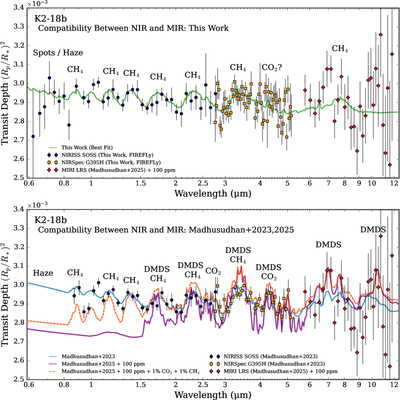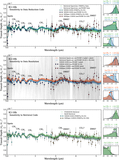Image Details

Caption: Figure 14.
Extrapolated best-fit models compared to additional JWST transmission spectra of K2-18 b. Top: best-fitting POSEIDON model to the low-resolution FIREFLy near-infrared data (NIRISS SOSS, R ≈ 25; NIRSpec G395H, R ≈ 100) extrapolated into the mid-infrared for comparison with the MIRI LRS data from N. Madhusudhan et al. (2025) (R ≈ 40). Bottom: reproduction of the median model spectra from N. Madhusudhan et al. (2023; near-infrared only) and N. Madhusudhan et al. (2025; mid-infrared only) with POSEIDON, each extrapolated over the wavelength range of the other data sets. All models are shown binned to R = 100 for clarity, and a 100 ppm offset is applied to the MIRI LRS data, and the models corresponding to N. Madhusudhan et al. (2025), to account for differences in the baseline transit depth. The model from this study, exhibiting no absorption features from DMS or DMDS, provides an adequate fit to the MIRI data. However, the median atmospheric properties from N. Madhusudhan et al. (2025) predict DMDS absorption features with amplitudes inconsistent with the near-infrared data. Near-IR (NIR); mid-IR (MIR).
Copyright and Terms & Conditions
© 2025. The Author(s). Published by the American Astronomical Society.












